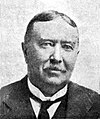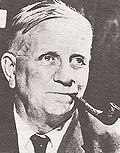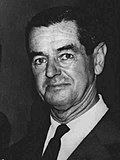| No. | Portrait | Name
(Birth–Death)
Constituency | Term of office | Elected
(Parliament) | Political party |
|---|
| Took office | Left office | Time in office |
|---|
| 1 |  | Charles Coghlan
(1863–1927)
MP for Bulawayo North | 1 October 1923 | 28 August 1927 | 3 years, 331 days | 1924 (1st) | Rhodesia Party |
|---|
| Introduction of responsible government, after the 1922 referendum. Formation of Southern Rhodesia. Oversaw the government's purchase of the country from the British South Africa Company for £2.3 million. Opposed amalgamation with either Northern Rhodesia or the Union of South Africa. Died in office. |
| 2 |  | Howard Moffat
(1869–1951)
MP for Gwanda | 2 September 1927 | 5 July 1933 | 5 years, 306 days | — (1st)
1928 (2nd) | Rhodesia Party |
|---|
| Viewed as a conservative, who believed that Rhodesia would eventually join the Union of South Africa. He oversaw the purchase, for £2 million, of the British South Africa Company's remaining mineral rights in Southern Rhodesia. His government passed the 1930 Land Apportionment Act, which defined the pattern of land allocation and ownership and is viewed as being one of the ultimate causes of the land disputes in Zimbabwe from 2000. Resigned. |
| 3 |  | George Mitchell
(1867–1937)
MP for Gwanda | 5 July 1933 | 12 September 1933 | 69 days | — (2nd) | Rhodesia Party |
|---|
| Changed the title from Premier to Prime Minister. Shortest serving Prime Minister of Southern Rhodesia. Lost the 1933 general election to Reform Party. |
|  | Godfrey Huggins
(1883–1971)
MP for Salisbury North | 12 September 1933 | 7 September 1953 | 19 years, 360 days | 1933 (3rd)
1934 (4th)
1939 (5th)
1946 (6th)
1948 (7th) | Reform Party
(until 1934)
United Party
(from 1934) |
|---|
| 4 |
|---|
| Longest serving Prime Minister of Southern Rhodesia. Created coalition with Rhodesia Party to form the United Party. World War II. Became an advocate of federating Southern Rhodesia with some of the neighbouring British colonies in the region so that they would become an independent state within the British Empire while maintaining white minority rule with only a small number of educated blacks qualifying for the vote in addition to most whites. As a result of his effort the Federation of Rhodesia and Nyasaland was created in 1953 uniting Northern Rhodesia, Southern Rhodesia and Nyasaland. Resigned to become the first Prime Minister of the Federation. |
|
|---|
| 5 |  | Garfield Todd
(1908–2002)
MP for Shabani | 7 September 1953 | 17 February 1958 | 4 years, 163 days | — (7th)
1954 (8th) | United Rhodesia Party |
|---|
| Introduced modest reforms aimed at improving the education of the Black majority. Also introduced the appellation "Mr" for Blacks instead of "AM" an appellation derived from their patois language. Under influence from large alcohol distributors, his government ended prohibition under which black population were unable to buy and sell alcohol in their designated areas. In a major breakthrough, Todd pushed a bill allowing for multiracial trade unions, thereby undercutting the growing white nationalist influence in the unions. Lastly, in a bid to increase the number of Blacks eligible to vote from 2% to 16% of the electorate, he lowered property and education qualifications, but this was soundly rejected. These reforms were seen as dangerously radical by most whites, and he was forced to resign. |
| 6 |  | Edgar Whitehead
(1905–1971)
MP for Salisbury North | 17 February 1958 | 17 December 1962 | 4 years, 303 days | — (8th)
1958 (9th) | United Federal Party |
|---|
| Oversaw continued rapid economic growth but also the beginnings of the dismantling of the Federation of Rhodesia and Nyasaland against the wishes of his party. He was crucial in the negotiation of the 1961 constitution, which increased black representation in the Southern Rhodesian parliament. He relaxed racial discrimination laws and attempted to enroll black voters, but this was done against a background of civil unrest and a tightening of security measures. The policies of his government caused alarm among the white population, while the blacks remained dissatisfied with the advances they had made. Lost the 1962 general election to Rhodesian Front. |
| 7 |  | Winston Field
(1904–1969)
MP for Marandellas | 17 December 1962 | 13 April 1964 | 1 year, 118 days | 1962 (10th) | Rhodesian Front |
|---|
| Dissolution of the Federation of Rhodesia and Nyasaland; his government won the majority of the Federation's military and other assets for Southern Rhodesia. Forced to resign after his failure to win independence from the United Kingdom. |
| 8 |  | Ian Smith
(1919–2007)
MP for Umzingwane | 13 April 1964 | 1 June 1979 | 15 years, 49 days | — (10th)
1965 (11th)
1970 (12th)
1974 (13th)
1977 (14th) | Rhodesian Front |
|---|
| His government issued the Unilateral Declaration of Independence (UDI) from the United Kingdom on 11 November 1965, causing widespread international condemnation and the first instance of economic sanctions in the history of the United Nations, led by Britain and the Organization of African Unity. Enjoyed limited support of South Africa and Portugal. Declared Rhodesia to be a republic on 2 March 1970, after the 1969 referendum. The Rhodesian Bush War started in 1964, and escalated into a full-scale conflict after 1972. Rhodesia's isolation intensified once Mozambique became independent from Portuguese rule in 1975, and when South Africa started to scale back its support. Under mounting isolation and international pressure, Smith conceded to a form of majority rule in 1978, by signing the Internal Settlement with moderate black nationalist leader Abel Muzorewa (this act was unrecognized by the international community and by main black nationalist groups). As part of this settlement, the 1979 referendum and the general election were held, the first multi-racial parliamentary elections (but with separate black and white rolls). Following the election, Rhodesia was renamed Zimbabwe Rhodesia and Muzorewa succeeded Smith as Prime Minister. |









